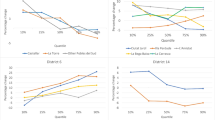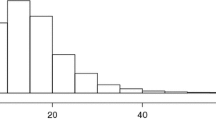Abstract
Block rate pricing is often applied to income taxation, telecommunication services, and brand marketing, in addition to its best-known application in public utility services. Under block rate pricing, consumers face piecewise-linear budget constraints. A discrete/continuous choice approach is usually used to account for piecewise-linear budget constraints in demand and price endogeneity. A recent study proposed a method to incorporate a separability condition ignored by previous studies, by implementing a Markov chain Monte Carlo simulation based on a hierarchical Bayesian approach. To extend this approach to panel data, our study proposes Bayesian hierarchical models incorporating random and fixed individual effects.
Similar content being viewed by others
References
Amemiya, T. (1985) Advanced Econometrics, Cambridge, MA: Harvard University Press.
Chamberlain, G. (1980) “Analysis of Covariance with Qualitative Data”, Review of Economic Studies, Vol. 47, pp. 225–238.
—— (1984) “Chapter 22: Panel Data”, in Z. Griliches and M. D. Intriligator, eds, Handbook of Econometrics, Vol. 2, Amsterdam: North-Holland, pp. 1247–1318.
Chib, S. (2001) “Chapter 57: Markov Chain Monte Carlo Methods: Computation and Inference”, in J. J. Heckman and E. Leamer, eds, Handbook of Econometrics, Vol. 5, Amsterdam: North-Holland, pp. 3569–3649.
Dalhuisen, J. M., R. J. G. M. Florax, H. L. F. de Groot and P. Nijkamp (2003) “Price and Income Elasticities of Residential Water Demand: A Meta-Analysis”, Land Economics, Vol. 79, No. 2, pp. 292–308.
Doornik, J. A. (2002) Object-Oriented Matrix Programming Using Ox, 3rd edn., London: Timberlake Consultants Press and Oxford.
Geweke, J. (1992) “Evaluating the Accuracy of Sampling-Based Approaches to the Calculation of Posterior Moments”, in J. M. Bernardo, J. O. Berger, A. P. Dawid and A. F. M. Smith, eds, Bayesian Statistics 4, Oxford: Oxford University Press, pp. 169–193.
Gupta, A. K. and D. K. Nagar (2000) Matrix Variate Distributions, Volume 104 of Monographs and Surveys in Pure and Applied Mathematics, Boca Raton: Chapman and Hall.
Hausman, J. A. (1985) “The Econometrics of Nonlinear Budget Sets”, Econometrica, Vol. 53, No. 6, pp. 1255–1282.
Hewitt, J. A. and W. M. Hanemann (1995) “A Discrete/Continuous Choice Approach to Residential Water Demand under Block Rate Pricing”, Land Economics, Vol. 71, pp. 173–192.
Hurwicz, L. and H. Uzawa (1971) “Chapter 6: On the Integrability of Demand Functions”, in J. S. Chipman, L. Hurwicz, M. K. Richter and H. F. Sonnenschein, eds, Preferences, Utility, and Demand, The Harbrace series in business and economics, New York: Harcourt, Brace, Jovanovich, pp. 114–148.
Lindley, D. V. and A. F. M. Smith (1972) “Bayes Estimates for the Linear Model”, Journal of the Royal Statistical Society. Series B, Vol. 34, No. 1, pp. 1–41.
Miyawaki, K., Y. Omori and A. Hibiki (2010) “Bayesian Estimation of Demand Functions under Block Rate Pricing. University of Tokyo CIRJE Discussion Paper Series CIRJE-F-712, Revised Version of CIRJE-F-424, CIRJE-F-568, and CIRJE-F-631”, University of Tokyo.
Moffitt, R. (1986) “The Econometrics of Piecewise-Linear Budget Constraint”, Journal of Business and Economic Statistics, Vol. 4, No. 3, pp. 317–328.
da Motta, R. S., R. M. Huber and H. J. Ruitenbeek (1998) “Market Based Instruments for Environmental Policymaking in Latin America and the Caribbean: Lessons from Eleven Countries”, Environment and Development Economics, Vol. 4, pp. 177–201.
Mundlak, Y. (1978) “On the Pooling of Time Series and Cross Section Data”, Econometrica, Vol. 46, No. 1, pp. 69–85.
Olmstead, S. M. (2009) “Reduced-Form Vs. Structural Models of Water Demand under Non-Linear Prices”, Journal of Business and Economic Statistics, Vol. 87, No. 1, pp. 84–94.
——, W. M. Hanemann and R. N. Stavins (2007) “Water Demand under Alternative Price Structures”, Journal of Environmental Economics and Management, Vol. 54, No. 2, pp. 181–198.
Pint, E. M. (1999) “Household Responses to Increased Water Rates during the California Drought”, Land Economics, Vol. 75, pp. 246–266.
Rietveld, P., J. Rouwendal and B. Zwart (2000) “Block Rate Pricing of Water in Indonesia: An Analysis of Welfare Effects”, Bulletin of Indonesian Economic Studies, Vol. 36, No. 3, pp. 73–92.
Robinson, J. A. (1997) “Chapter 21: Long-Term Consequences of Population Growth: Technological Change, Natural Resources, and the Environment”, in M. R. Rosenzweig and O. Stark, eds, Handbook of Population and Family Economics, Vol. 1B, Amsterdam: North-Holland, pp. 1175–1298.
Smith, A. F. M. (1973) “A General Bayesian Linear Model”, Journal of the Royal Statistical Society. Series B, Vol. 35, No. 1, pp. 67–75.
Spiegelhalter, D. J., N. G. Best, B. P. Carlin and A. van der Linde (2002) “Bayesian Measure of Model Complexity and Fit”, Journal of the Royal Statistical Society. Series B, Vol. 64, No. 4, pp. 583–639.
Szabó, A. (2009) “The Value of Free Water: Analyzing South Africa’s Free Basic Water Policy”, mimeo, University of Minnesota.
Tanner, M. A. and W. H. Wong (1987) “The Calculation of Posterior Distributions by Data Augmentation”, Journal of American Statistical Association, Vol. 82, No. 398, pp. 528–540.
Author information
Authors and Affiliations
Additional information
We greatly appreciate the beneficial comments and suggestions from two anonymous referees and the editorial support from the editor, K. Ohtani (Kobe University). This work is supported by Grants-in-Aid for Scientific Research 21243018 and 22330069 from the Japanese Ministry of Education, Science, Sports, Culture and Technology and by the Academic Frontier Project of the Nihon University Population Research Institute. The authors thank H. Kozumi (Kobe University) and K. Kakamu (Chiba University) for their valuable comments. All computational results were obtained using Ox for Linux (see Doornik, 2002).
Rights and permissions
About this article
Cite this article
Miyawaki, K., Omori, Y. & Hibiki, A. Panel Data Analysis of Japanese Residential Water Demand Using a Discrete/Continuous Choice Approach. JER 62, 365–386 (2011). https://doi.org/10.1111/j.1468-5876.2010.00532.x
Accepted:
Published:
Issue Date:
DOI: https://doi.org/10.1111/j.1468-5876.2010.00532.x




